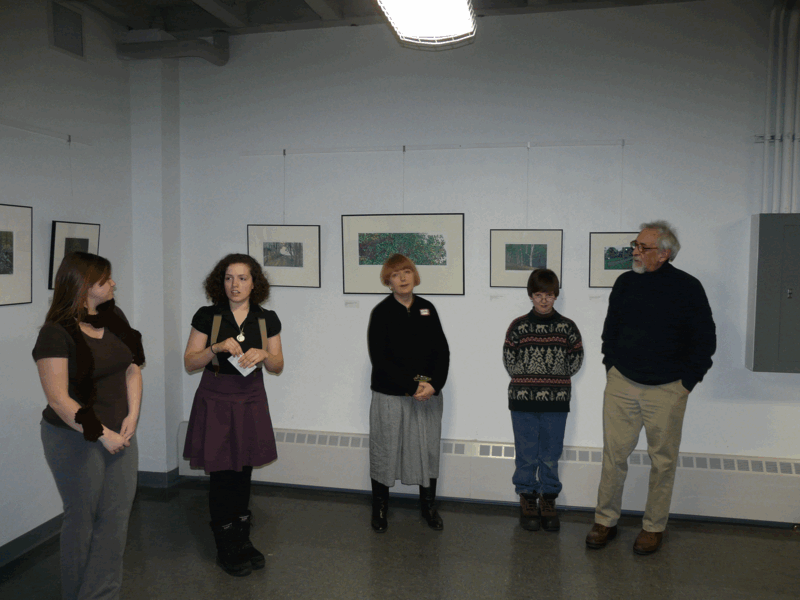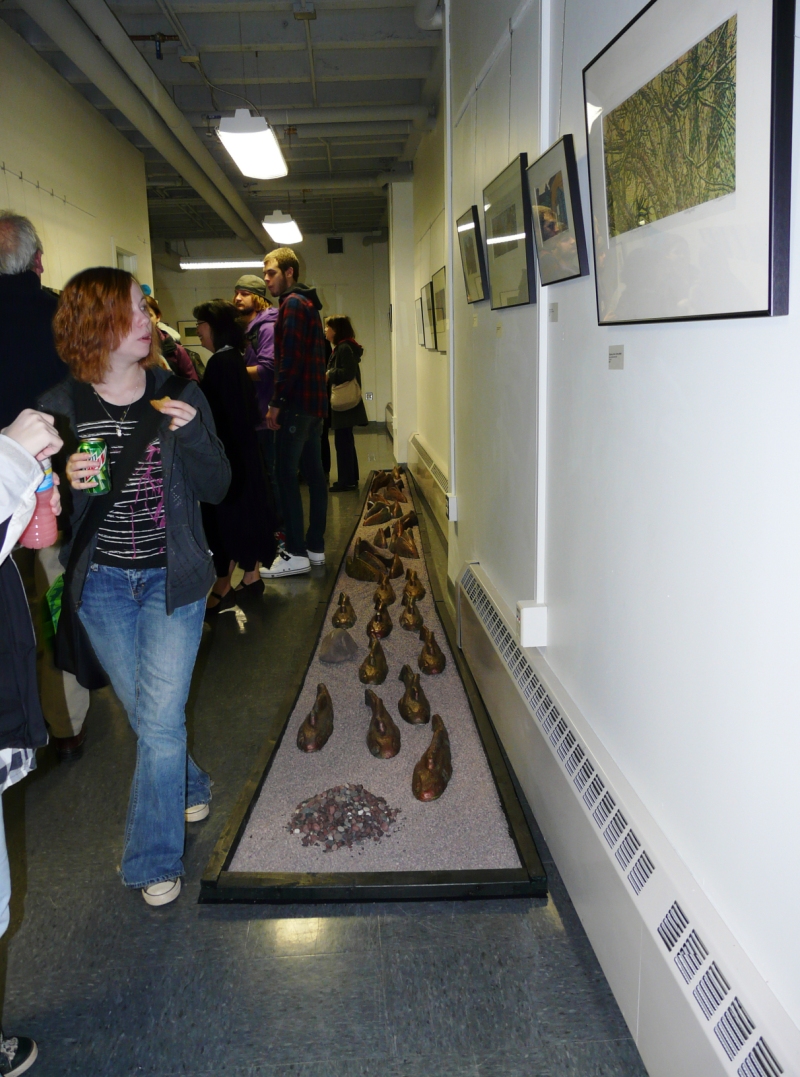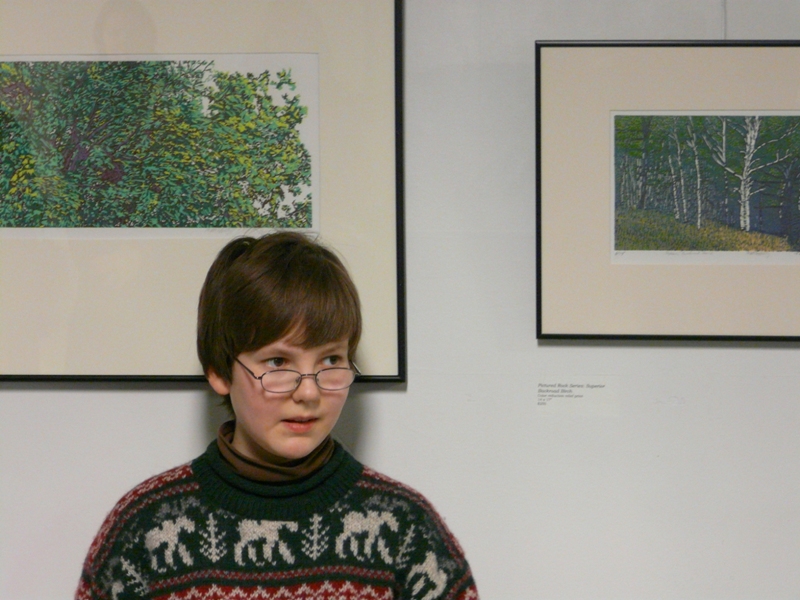|
|
|
After thinking for several months as to what process would work for
them, they decided to work together creating color reduction relief
prints. In the reduction process a single woodblock is used and the wood
is gradually carved out between each color run. The reduction process is
sometimes jokingly called a “suicide” print because, as carving
progresses, the previous states are destroyed. There can be no additional
prints made of a reduction woodblock. If the edition says 20 you can be
sure there will never be any more. Because it is not possible for the
artist to go back to redo a state, considerable thought has to be done in
planning the design as well as the actual carving out of the wood.
It
is critical to place the woodblock and paper together in the exact same
way each time a color is added. This relationship is called registration.
The printmaker will have a method to make certain that registration occurs so
that all parts of the image line up correctly.
The sequence of
inking which provides that the lightest and most transparent colors are
done first and the darkest, most opaque colors printed last. This is not a
hard and fast rule because artists are creative and sometimes rules are
broken to arrive at special effects. As you look at color woodcuts you may
be able to determine the sequence of inking. Sometimes one of the colors
you see may be the color of the paper on which the inks are printed.
|
 |
|
|
|
On the first print they created, they used 20 pieces of paper and three turned
out. The registration process was the key. Tom told me that he now begins
by first pinning the paper to register all the sheets assuring more
accuracy. Color is still one of the bigger problems they face, deciding on
the layering of the different colors.
After a couple of lives which
involved growing up in northwestern Pennsylvania, a few years in the U.S.
Coast Guard, and a lackluster career in the grain business Tom decided to
follow his muse and study art. From that point in 1970 till now Rudd has
been in the art world, always making art but receiving money for teaching
and as an arts administrator.
Tom's teaching, visiting artist, and
artist residencies took him through reform schools, prisons and some
pretty outstanding colleges and universities across the U.S.
As an
arts administrator Tom facilitated a state program for support to
individual artists, directed projects for a public art program and was
visual arts coordinator for yet another state arts commission. He has
always been an artists' advocate but has remained on track as a working
artist through all these periods by producing, placing and showing art in
museums, art centers, galleries and private collections throughout the
world.
|
|
The objective of Tom Rudd’s life in the arts is creating visual art
that enlightens and stimulates aesthetic sensitivity. Rudd pursues this
goal by making art, teaching, administrating, curating, and advocating for
artists and the visual arts. He has shown and placed his art in public
and private venues throughout the world, and has received numerous grants
and awards.
Before discovering that art was her vocation, Margo
McCafferty , a native of the Pacific Northwest, received a degree in
political science before deciding that art was her vocation. After earning
her MFA in painting and drawing she settled in to the reality of teaching.
Her teaching experience includes English in Japan, painting, drawing,
design and printmaking for colleges and universities. Other jobs (past and
present) include arts administration on the state level, writing art
reviews, making and showing art, home schooling and mothering.
Margo's work is shown and collected internationally.
|
|
Each year the artists complete at least one series. Some of the relief
prints focus on the Cascade Mountains in western Oregon, others on the
Allegheny River Valley in western Pennsylvania, Isle Royale National Park,
Pictured Rocks National Lake Shore, and the Midwest’s rustbelt. They are
presently working on a series that reflects happenings and landscapes of
the Keweenaw Peninsula.
Tom and Margo make their prints
during the winter months. The remainder of the year each pursues their own
art interest. Tom and Margo will be doing a series as they work with
the Finlandia art students. Tom said one of the difficulties they face is
that it is usually six to nine months between print making sessions and
some aspects of the learning curve begin all over again.
They
stated that the Finlandia exhibit was the largest number of prints to be exhibited at one
time.
|
 |
|
In addition to the fantastic prints, Tom is exhibiting an installation
piece. He calls it “his work in progress” It is a streambed
with fish swimming upon it. He has made three different fish designs which
he then casts in plaster and painted. Margo thinks that it would make a
great sculpture for their garden. The piece seems to take form from Tom’s
experiences in Japan. Both he and Margo have gone to Japan and were influenced
by Japanese art. Equally so, both have been influenced by nature, readily
visible in their wonderful art.
|
|
|
|
Their prints will be on exhibit at the Reflection gallery until
March 29th. Their work can also be seen during Fusionfest. |
 |
|
Joining Tom and Margo was their son Max. Max is also an artist, as his
sister. Max is very computer literate and is currently creating cartoons.
We invited Max to send us one of his creations
to exhibit on our website. In this Keweenaw Household “Art, certainly
is a Family Affair.”
|
|
|
|
Rudd and McCafferty will conduct a greeting card printmaking workshop
on Saturday, March 20, 2010, 1:00 to 5:00 p.m. The workshop is open to the
public and will take place at the Finlandia University Jutila Center, 200
Michigan St., Hancock. The cost of the workshop is $25 per person, with
supplies included.
Please e-mail
finlandiareflectiongallery@gmail.com to reserve one of only 15 available
spaces in the workshop.
The Reflection Gallery is located on the
second level of Finlandia’s Jutila Center campus.
For additional
information, please contact Yueh-mei Cheng, associate professor of studio
arts, at 906-487-7375 or
yueh-mei.cheng@finlandia.edu.
|
|
|
|
IronwoodInfo.com is a Michigan,
Non-Profit Media Corporation
Contact
IronwoodInfo.com
email:
mail@ironwoodinfo.com
snail mail: P.O. Box 305 Ironwood, MI 49938
Telephone
906-885-5683
Fax
906-884-2544
|
?
|

